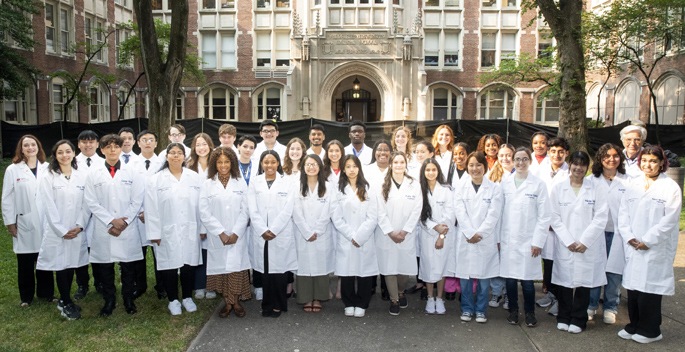
A research paper co-authored by 23 high school and undergraduate students participating in Vanderbilt University Medical Center’s Aspirnaut summer research program has been selected as one of the “Editor’s Picks” by the Journal of Biological Chemistry.
Aspirnaut is a STEM pipeline program “for diversity and wellness” that offers intellectually challenging experiences and opportunities in science, technology, engineering and mathematics to talented youth from rural and diverse backgrounds.
For more than a decade, successive groups of “Aspirnauts” participating in the summer research program at VUMC have investigated the organization and evolution of the collagen IV scaffold, the fundamental architectural unit of the basement membrane that connects cells and strengthens tissues.
Understanding how this protein scaffold bridges the transition from unicellular to multicellular animal life sheds light on diseases as diverse as kidney failure and cancer, said Aspirnaut co-founder Billy Hudson, PhD, the Elliott V. Newman Professor of Medicine known for his contributions to the field of matrix biology.
Among the lab techniques the students learned was polyacrylamide gel electrophoresis, which is used to separate proteins. Sergey Budko, PhD, assistant professor of Medicine and first author of the paper, modified the technique by adding an amount of salt sufficient to keep collagen IV intact during separation.
The modified technique, he said, enabled the students to analyze multiple tissues from 34 different animals and to discover the “primordial role” that chloride ions, through the pressure they exert on cells, play in driving collagen IV assembly and stability.
The JBC editors, in their special recognition of the paper, which was posted online prior to publication, noted that this work provides “an exceptional contribution to the field.”
“The fundamental discovery of Aspirnauts profiled in this paper underscores the power of what a team of talented high school and undergraduate students can accomplish with excellent mentorship and a well-planned scientific expedition,” said Julie Hudson, MD, Aspirnaut co-founder and executive director.
Since the summer research program was launched in 2009, more than 300 students from 34 states have participated. To date, nearly 90 have gone to earn MD degrees, PhDs, or both.
Their research findings have been published in prestigious journals including Nature Chemical Biology, the Proceedings of the National Academy of Sciences (PNAS), eLife, and now, JBC.
In addition to Budko and the Hudsons, co-authors of the paper from VUMC included Vadim Pedchenko, PhD, Elena Pokidysheva, PhD, Rachel Baugh, MS, Aaron Fidler, PhD, Sergey Ivanov, PhD, Tetyana Pedchenko, PhD, Mohamed Rafi, MS, Roberto Vanacore, PhD, and Gautam Bhave, MD, PhD.
Aspirnaut co-authors were Octavia Ailsworth, ZaKylah Bryant, Camryn Cole, Jacob Edward, Di’Andra Edwards, Sydney Farrar, Julianna Gallup, Michael Gallup, Martina Gergis, Aalia Holt, Madeline Lach, Elizabeth Leaf, Finn Mahoney, Max McFarlin, Monica Moran, Galeesa Murphy, Charlotte Myers, Connie Ni, Neve Redhair, Rocio Rosa, Olivia Servidio, Jaeden Sockbeson and Lauren Taylor.
The research was supported by National Institutes of Health grants R01DK018381 and R01DK131101. The Aspirnaut high school students were supported by the Springer-Lu Family Foundation of Chestnut Hill, Massachusetts, and the undergraduate students by NIH grant R25DK096999.












